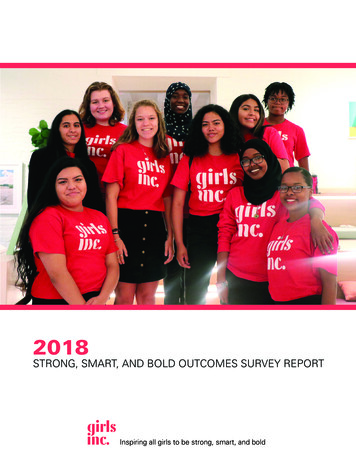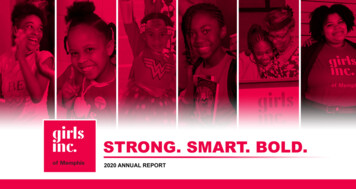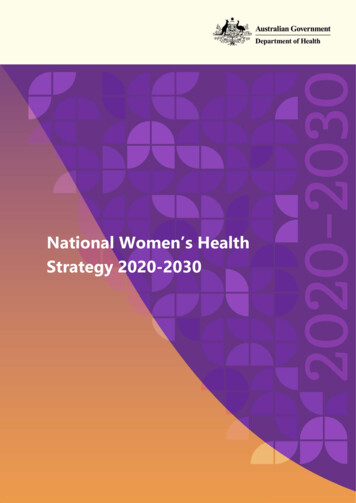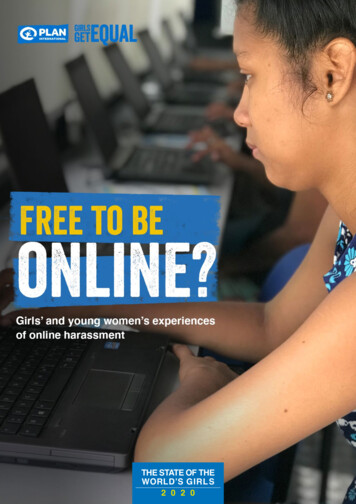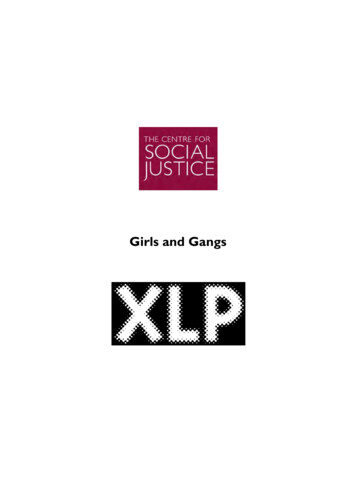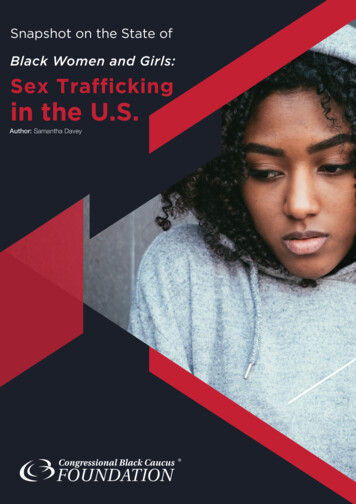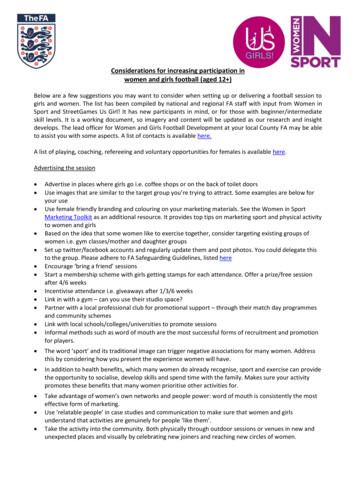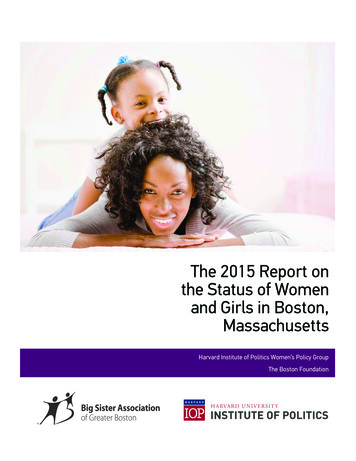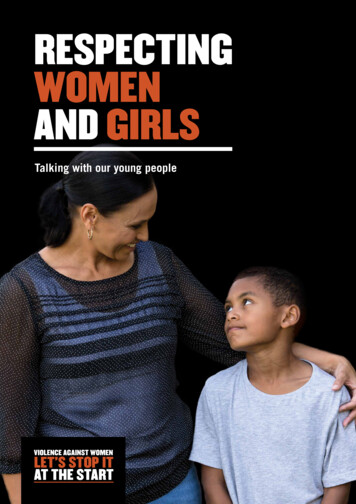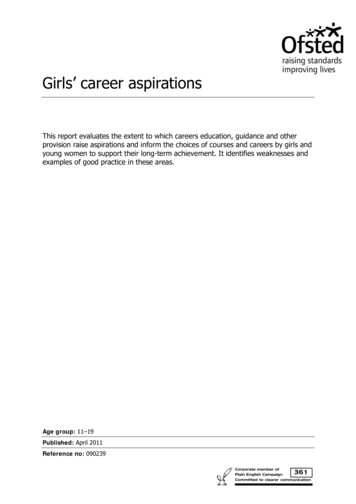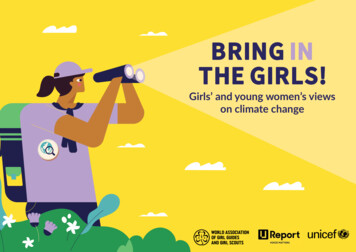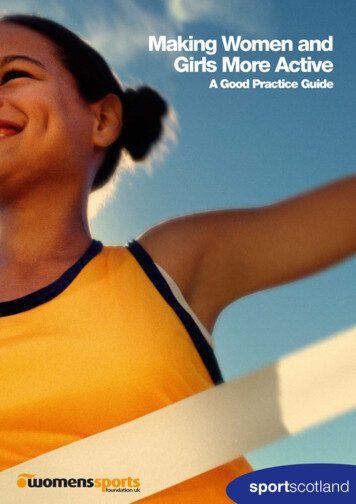
Transcription
Making Women andGirls More ActiveA Good Practice Guide
“From the first steps in theplayground to the stepsonto the podium, we’rewith women in Scottishsport all the way”Julia Bracewell OBE
01Forewordby Julia Bracewell OBEChair, sportscotlandSport is an essential part of my life. To imagine a life without sport is a difficult conceptfor me. I grew up with it, and was encouraged to pursue it passionately. My sportinglife started with dancing and continued with fencing - first as a seven year old in myback garden, eventually as an Olympic athlete.Despite my passion for sport, it hasn’t always been easyto make time for it; work, children, and simple day to dayliving sometimes conspire to make it impossible. But therewards have always made the effort worth it. Sportbenefits mind, body and spirit – and I believe everyoneshould have the opportunity to enjoy these benefits.For those of us involved in sport and privileged enoughto enjoy it on a regular basis, it’s sometimes hard tounderstand why others do not participate. Reading thisguide tells us why. If we have a greater understandingof the reasons girls and women do not take part inphysical activity, we have a better chance of helpingthem gain access, embrace opportunity and enjoysport and taking part in physical activity.Great things start with small steps. For me it was fencingas a young girl, and wanting to be a part of the OlympicsI saw on TV. For others, it might be the freedom to take aswim, the chance to try out a new sport, or simply the timeto take a walk. No matter what the aspiration, no matterthe sport or activity, having the time and opportunity issomething every woman and girl deserves.We can all play a part in making a physically active lifepossible for all women and girls, no matter what their age,circumstances or life choices. Let this guide be thebeginnings of those efforts, and herald a new era forwomen and girls in sport.Good luckThe fitness and wellbeing of women and girls in Scotlandhas been on the political agenda for some time.sportscotland, the Scottish Executive and a number oforganisations within Scottish Health have identified womenand girls as a group that are under-represented in sportand need more opportunities and targeted work in orderto address their levels of fitness and general health. Theseare the facts. The challenge to those of us working in thefield of sport and physical activity; to get more girls andwomen more active, more often. This guide seeks to helpthe Scottish sporting community rise to the challenge ofhelping girls and women live a more active life throughproviding background on the barriers they face andpractical recommendations and advice on breakingdown these barriers.The challenge of lower female activity levels is not anew one, and much good work and progress has beenmade by many. We’ve relied on them for the advice andinformation in this guide; the good practice examplesalone demonstrate that massive inroads into this areaare being made. I give my sincere thanks to those whohave contributed thus far, and urge them to continuetheir good work.Thanks to our partner:
02
03ContentsForewordIntroduction010401 BenefitsThe Benefits of Physical ActivityPhysical healthPsychologicalSocial08080902 BarriersBarriers for women and girlsHow can we explain the difference between the sexes?The lifecycle of womenPractical BarriersLack of time and childcareLack of moneyLack of transportPersonal safetyFundingAccess to facilitiesPersonal BarriersBody imageClothing and equipmentLack of self-confidenceParental and adult influenceSocial and Cultural BarriersMale-dominated culture of sportAttitudes and prejudices about sexualityAttitudes and prejudices about disabilityAttitudes and prejudices about ethnicitySexual harassment and abuseFemale invisibility – media representationsand lack of role models in sport13141618192020222427282930323335363803 SupportSupport for Good PracticePrinciples of equitable practiceThe legal framework for equalityRelevant legislationUseful terminologyCommitted to good practiceUseful organisationsAcknowledgements43444445474748
04An Introduction toGender Equality in SportThis Good Practice Guide is for those working within sport and physical activity,whether it is in schools, leisure centres, clubs, governing bodies of sport or in otherareas of the community. Its aim is to provide advice, information and good practiceexamples for anyone planning or delivering programmes of sport and physical activity.This Guide has grown out of a partnership with theWomen’s Sports Foundation (WSF). It details theinequalities that exist in sport and physical activities andprovides you with information on women’s participation insport and physical activity. It also offers advice andrecommendations on how to overcome many of thebarriers faced by women and girls taking part or wishingto take part in sport and physical activity. It intends toshow how we can work towards a greater gender equalityin sport and make sport and physical activity moreaccessible for all women and girls.Throughout the guide you will find practical advice as wellas good practice from all over the country. Having spentsome months travelling around Scotland delivering trainingand meeting with people working with girls and womenin the area of sport and physical activity I have seen atfirst hand some of the fantastic work that is being done.I have also begun to understand some of the problemsand barriers practitioners are faced with when deliveringactivities, sourcing funding and working to effect changefor girls and women in a very diverse Scotland.We’d like to know what sections of the guide you finduseful and any good practice or ideas from your own workin achieving gender equality in sport. There is a lot of goodwork being done in various areas and communities andwe’d like to hear about initiatives worthy of recognition.Please let us know what good work you are doing bycontacting us at sportscotland – details at the back ofthe guide. We’d also recommend looking at wider goodpractice examples at www.whatworksforwomen.org.uk,a fantastic resource showcasing initiatives from acrossthe UK – you can also register good practice here.With the new duty on the public sector to promote genderequality due to arrive in December 2006, sport and leisurewill need to assess their policies and practices and the aimis that this guide will be one useful tool in this work.We hope you will find this Guide a useful and supportiveresource that assists you in your work with girls andwomen in sport and physical activity. We can all play arole in making women and girls more active and sharinggood practice can only help us get better at what we do.Please continue to let us know about all of the good workgoing on across the country.Jessica LindohfWomen, Girls and Sport OfficersportscotlandGender Equality means that women and men have equal conditions forrealising their full human potential, enjoying civil rights andfor contributing to, and benefiting from, economic, social,and political development.Gender equality is therefore the equal valuing by societyof the similarities and the differences of men and women,and the roles they play.1Women’s Sports Foundation UKThe Women’s Sports Foundation, founded in 1984, is thenational non-governmental organisation solely committedto improving and promoting opportunities for women andgirls in sport at every level.We work through a combination of advocacy, information,education, research and training.Our vision is of a society which celebrates the diversity ofwomen and girls and enables them to benefit from, excelat and fulfil their potential through the sport of their choice.
05sportscotland and the Womens’s Sports Foundationare committed to promoting Good Practice in sport andphysical activity to ensure that more women and girls inScotland benefit from all the advantages of an active life.This guide is a collaboration between sportscotland andthe Women’s Sport Foundation (WSF).sportscotland’s corporate strategy is inspired by theobjectives of Sport 21: The National Strategy for Sportwhich maintains a vision of Scotland as: a country where sport is more widely available to all; a country where sporting talent is recognised andnurtured; and a country achieving and sustaining world classperformances in sport.In relation to the first element of this vision, women andgirls have been identified as one of the key groups to focuson in order to increase participation in sport. Several of thetargets of Sport 21 identify the importance of increasingwomen and girls’ participation in sport, particularly inaddressing drop off in participation in the teenage years.sportscotland is absolutely committed to promoting equityin our organisation and in Scottish sport, and we believethat the principles of equity should be central to everyaspect of development, delivery and decision making insport. That means ensuring that diversity in sport isencouraged, supported and celebrated.The importance of advocating and supporting morewomen and girls to participate in sport is highlighted insportscotland’s Women and Girls Equity and DiversityStrategy, as well as in sportscotland’s overall EquityStrategy: Working Towards Diversity and Inclusion in Sport.The Equity Strategy sets out sportscotland’s commitmentto increasing equity, diversity and inclusion in sport andoutlines our targets and intended outcomes for 2005-2007.sportscotland will deliver this strategy by implementing theEquity Standard: A Framework for Sport, developed by thefour home country sports councils and UK Sport in 2004as a tool to assist sports organisations taking steps toincrease equity in their organisation and services.Through sportscotland’s investment in the Active SchoolsNetwork we aim to increase activity amongst: school aged children; girls and young women; children and young people from ethnic-minoritycommunities; children and young people with physical and learningdisabilities; and children and young people in areas of socio-economicdisadvantage.
01 Benefits“In the UK, obesity hastrebled since 1980 andcontinues to increase at analarming rate. 1 in 3 girlsaged 11 is overweight”
08 BenefitsThe Benefits of Physical ActivityBeing active is good for all of us. The benefits described in this section are just someof the reasons why many of us exercise – and some of the reasons why we shouldencourage others to be active.The benefits fall into three categories:1 Physical Health2 Psychological3 Social1 Physical health“Physically activepeople are at abouthalf the risk ofcoronary heartdisease comparedto those with asedentary lifestyle”Being physically active has a significant positive impact onour physical well-being. It helps: those who smoke to give up; prevent coronary heart disease; prevent osteoporosis; prevent late onset diabetes (Type II); prevent high blood pressure (hypertension); prevent obesity and assist with weight control. Obesityand being overweight can lead to other health problems,such as heart disease, high blood pressure, diabetes,bronchitis and osteoarthritis. The good news is thataerobic exercise can lead to moderate weight loss, evenwithout dieting. Dieting combined with physical activityis one of the most effective ways of managing mild tomoderate obesity; prevent some cancers, such as cancer of the colon,breast, kidney, endometrium and prostrate, as well ascancers which are linked to being overweight or obese; develop and maintain physical competence. For example,regular exercise can help children develop coordinationand can reduce memory loss in older people; prevent and treat non-specific back pain.2 PsychologicalRegular physical activity also has fantastic benefits for ourpsychological and emotional well-being. It can: raise self-esteem and self-confidence, energy, alertnessand awareness; encourage better sleep patterns; reduce and prevent depression by stimulatingchemicals in the brain (endorphins) which act asnatural mood enhancers; reduce feelings of stress and anxiety; improve body image. Poor body image is a particularproblem for adolescent girls, and can contribute toeating disorders such as anorexia and bulimia. Physicalactivity and sport can help improve body image andthereby prevent eating disorders.
Benefits 093 SocialAs well as individuals, communities also benefit from sportand physical activity. It can help: develop social skills. Young people who participate insports can learn social skills and the value of hard work,fair play and teamwork. Physical activity can providea safe and supportive environment for children andyoung people to explore their strengths, develop skillsand test their limits. This can help young people growinto capable, well-balanced, productive members ofthe community; improve academic performance. Athletic participationis linked to favourable academic outcomes, includingbetter grades, fewer disciplinary referrals, lowerabsenteeism and drop-out rates, and increasedcommitment to further education;2 reduce anti-social behaviour, social exclusion andloneliness across all age groups. Physical activity isparticularly important for helping adolescents throughthe years of transition to adulthood. The on-going socialrelationships and skills that develop from taking part insport can provide a core of social resources to supportand protect children and adolescents as they mature; improve sexual health and well-being. Girls who playsports are less likely to have unprotected sex or havean unplanned pregnancy.3Did you know? Coronary Heart Disease (CHD) and stroke are majorcauses of premature deaths, causing about 18,000(1/3 of all deaths) in men and 7,000 (1/5 of all deaths)in women under 65yrs. However, physically activepeople are at about half the risk of CHD comparedwith those with a sedentary lifestyle. 80% of the 6,000 hip fractures which occur each yearin the UK are experienced by women over 50yrs of age.Weight-bearing exercise helps maintain body mass andcan reduce the risk of a hip fracture by up to 50%. In the UK, obesity has trebled since 1980 and continuesto increase at an alarming rate. Those particularly at riskof obesity and being overweight are those (especiallywomen) living on a low income, those with obeseparents as well as some ethnic groups such as AfroCaribbean and Pakistani people. 1 in 3 girls aged 11 is overweight.
02 Barriers“Almost 3.5 hours of awoman’s day is taken upwith domestic work,compared to less than2 hours for men”
12 Barriers
Barriers 13Barriers for women and girlsIt’s clear that taking part in regular sports or physical activity is good for individuals andgood for communities. Despite this, women and girls are far less likely to be physicallyactive than men or boys: the gap between women and men’s participation in sport inScotland currently stands at 12%.There are also significant differences in what activitieswomen and girls and men or boys do as well as howthey do those activities. Women and girls tend to bemore involved in non organised activities and as a resultare less likely to be affiliated with a sport club or otherorganised sport organisation. In Scotland only a thirdof club members are adult females and just 5% are girlsunder the age of 16.4Did you know? Already at the age of 7 many more girls than boys havebeen put off sport.5 40% of girls have dropped out of all sports activity by thetime they reach 18.6 Almost half of adult women in Scotland (43%) participatein little or no sport at all7 and 79% of girls aged 8-15did not see being fit and healthy as important.8 Only 17% of girls in Primary 7 – Secondary 2 reportdoing moderate physical activity for 1 hour on morethan 5 days per week as recommended by nationalguidelines. In addition 42% of girls in this age groupreport doing 1 hour or less per week of vigorousphysical activity.9 Disabled women are 49% less likely to participate inexercise compared with the national average, whiledisabled men are 24% less likely to participate inexercise compared with the national average.101 How can we explain this differencebetween the sexes?There are many practical, personal, social and culturalbarriers to participating for women and girls. However,there are ways to overcome these barriers. In section 02,we outline the key reasons why women and girls don’ttake up sport or physical activity.Of course, these barriers will be different for differentpeople, and women and girls vary for a whole host ofreasons; personal character, ethnic background, socioeconomic group, sexuality, age, physical and mentalimpairments to name a few. It’s important to bear this inmind when thinking about what kinds of sport or physicalactivity will suit different groups of women and girls.To know how best to engage with women and girls, youneed to have an understanding of the particular barriersthey might face. This guide makes a start with that, butthe best way to understand is to ask women and girlsthemselves. Consultation with the ‘experts’ – womenand girls – is a key component of good practice.2 The lifecycle of womenAlthough all human beings grow up and grow older,women and men experience the aging process differently.Events and stages of people’s lives can affect them indifferent ways as they take on changing roles andresponsibilities and develop new interests and pastimes.For example, the arrival of a first baby seems to affectmost women’s lives more than men’s. At each stage of life,women and men might have quite different caring and(paid) work responsibilities.These events will leave them with more or less enthusiasm,time and money to take part in physical activity and sport.Attempts to engage women of all ages should take intoaccount the different motivations across each age group.Clearly, there is no ‘typical’ girl or woman and the lives ofwomen differ depending on, for example, income, ethnicity,disability, health, sexuality or motherhood. However,women may have similar experiences at similar stagesof life. The timeline of women’s lives that follows illustratesthe changes they may experience at different ages.Adults taking partin sport (excludingwalking) at leastonce a week inScotland: female24%, male 38%11
14 BarriersA Timeline of Women’s LivesAdolescence 11-16 yrsYoung Adult 17-24 yrsAdulthood 25-39 yrsThis is a time of important physicaland emotional changes and growthfor girls. They tend to be affectedby puberty earlier than boys andso-called ‘early’ and ‘late’ developersmay feel awkward and self-consciousas they experience growth spurts.They may also experience pressuresaround schoolwork, social life, ‘fittingin’, body image, sexuality and sexualactivity, being independent, familylife and expectations. Clearly, thereare many things competing for theattention of adolescent girls. Thesepressures explain the high drop inactivity participation rates ofadolescent girls.For most young adult women, this isa transitional period from educationto work, which brings newexperiences and challenges. It is thetime when they move away from theorganised sporting structures ofschool and many drop out of physicalactivity and sport. While there arepressures to be independent, moreand more young adults stay ineducation and live in the familyhome. Many young adult womenhave some disposable income,limited caring or other responsibilities,an active social life and an interestin appearance and ‘looking good’,which might provide the motivationto take part in physical activity.Others have the responsibilities,pressures and pleasures thatcome with motherhood.Many women look after children intheir late 20s and 30s, so, as wellas having the physical effects ofpregnancy and childbirth, thereare more demands on their time,finances and energy. As womenrather than men still take on themain caring role, many women withyoung children reduce their hoursof paid work and juggle the demandsof home and family. Typically, they’llfocus on their children’s health morethan their own, but the happinessand health of their children mightin turn provide a motivation tobe active.The timeline shows that women, like men, are nota homogeneous group, all sharing the same lifecircumstances. Instead, the priorities, pressures andmotivations of women to engage in sport or physicalactivity vary over their lifetimes.gyms might appeal to women in their 20s and 30s, it ismore likely to be intimidating or ‘boring’ for women intheir 50s and 60s. Older women are more likely to preferactivities which they don’t consider to be sport, such aswalking, dancing, swimming, gardening, yoga and cycling.Think about the different motivations for differentgenerations of women to take part and tailor your serviceand information accordingly. Ask women from yourpotential participant group which activities appeal to themand why, so that you can understand their motivationsand the other demands on their time, energy and money.Different women enjoy different forms of exercise and sportand although it is often assumed that adult and olderwomen are more interested in aerobic exercise andfitness classes, many would prefer team sports or morecompetitive activities. It’s often the assumption that womenwho take up or continue sport in their middle age or lateryears do it as a hobby rather than because they want toexcel. As a result competitive sport tends to be offered toyounger women, but it is important to recognise that olderwomen might also like to participate competitively andachieve at the highest levels.The types of activities that appeal to different age groupsalso vary. For example, many younger and older womenare attracted to dance (albeit different kinds of dance!) forthe psychological, social, emotional and physical benefitsit brings. And whilst exercising alone in state of the art
Barriers 15Middle Age 40-59 yrsThird Age 60-69 yrsOld Age 70 yrsMiddle-aged women may have agrowing young family and find thattheir lives are focused on familyactivities and concerns. Others mayfocus their energies on their careers.Most juggle both family and paidwork. Social lives and leisureactivities are likely to revolve aroundnetworks of family or workmates.Women may find they have very littletime for themselves and that caringfor others is their main priority.As children move out of the familyhome, women may find they havesignificantly more time on theirhands. At the same time, women’sown parents may need more careand support as they grow old.Women, rather than men, tendto take on these responsibilities.Women in their older years tend tobe more interested in living for todaythan preparing for tomorrow.This means that the motivation ofimproved health in the future is apoor motivator for physical activity.Chronic health problems anddisabilities often set in at aboutthis age and may influence awomen’s participation in sportand physical activity.Did you know? As women grow older their physical activity levels dropand whilst the age group 35-44 are the most activegroup only 34% of this group fulfil national guidelines.12 Among older women only 19% of those aged 55-64and 8% of those aged 65-74 fulfil guidelines of30 minutes of moderate activity 5 times per week.13 Older women, like younger women, find selfconsciousness about their body and their body imagedemotivators for taking part in physical activity.14 Older women in particular benefit from having socialsupport to encourage their participation in physicalexercise and for this group it is the social aspect oftaking part in exercise that is the greatest motivator.15Women of this age are less interestedin exercising for physical healthbenefits; they are more likely to enjoythe social relationships which canbe maintained through participatingin sport and physical activity. Theshared benefits of exercising withanother person (whether that’s afriend, a partner, a grandchild) oreven of walking the dog are moreimportant than the personal benefitssuch as health and well-being.
16 BarriersPractical BarriersPractical barriers can affect women and girls throughout their lives, or as their liveschange. The barriers they may face will depend partly on their circumstances andstage of life – for example whether they are mothers, disabled, living in poverty,in employment, even whether living in rural or urban areas.However, it’s unlikely that a woman won’t experience any ofthese barriers at some time in her life. Understanding howwidespread their effects are is an essential part of knowinghow to adapt provision of sport and physical activity sothat a wider range of women and girls can benefit.1 Lack of time and childcare2 Lack of money3 Lack of transport4 Personal safety5 Funding6 Access to facilitiesDid you know? Almost 3.5 hours of a woman’s day is taken up withdomestic work, compared to less than 2 hours for men.Food preparation takes up the bulk of the chores, withcleaning and shopping the next most time-consuming.16 Men do an average of 97 minutes longer paid work eachday than women, but women do around 2 hours morehousework and childcare than men.17 Lack of time is also a factor for girls taking part inphysical activity and sport and 34% of S2 girls cited lackof time as an important barrier, 43% also cited lack ofequipment as a major barrier.18 It is predominantly women who take time off to lookafter sick children, including 60% of women who earnthe same as or more than their partners. Workingmothers with children put twice as many hours intohousework as their partners.19 On average women tend to have less income than men;women working full time earn on average 559 or18% less per month than men do.201 Lack of time and childcareWomen tend to have less leisure time than men as theytake on the greater burden of responsibility for housework,childcare and care of elderly or infirm relatives. This is oneof the key reasons for not taking part in sport. Womenalso cite lack of childcare facilities as a major factordiscouraging them from taking part in sport and physicalactivity; in a recent study, four times as many women asmen identified this as a barrier.16 Girls are also likely to beaffected by this, as they’re more likely than their brothersto be expected to take care of siblings and to take onhousework and cooking.Recommendations Investigate options for the provision of childcare, or helpwith childcare costs, and adopt a child-friendly approachso that women can bring their children with them tothe venue. Provide crèche facilities and/or provide classes fortoddlers and children, either with or separate from theirparents, so that the adults can bring their children alongwhen they go to exercise. For example, parents andbaby aerobic classes could incorporate exercises likelunges with pushchairs, encouraging participants tosee how they can incorporate physical activity intotheir daily lives. Making physical activity a part of the working day canhelp address the lack of time so many womenexperience. For example, lunchtime walking, runningor exercise groups, supported by the employer, canhelp staff to fit physical activity into a busy working day.Encourage your employer to support such schemes. Provide sports facilities for schoolgirls during schoolhours or before the start of the school day as well asin the evening.
Barriers 17Good Practice ExampleBodyworks is operated by Argyll & Bute Council’s Out ofSchools Learning team. It’s an initiative which bringstogether individual PE-departments and local instructorsto run lunch time activity sessions in schools. Instructorsare provided by Bodyworks; half the cost is carried bythe school, the other half by Stramash, the overarchingproject funded by the Big Lottery.Bodyworks means that girls in rural areas who might findit difficult to take part in after-school activities becauseof time and travel constraints can take part in physicalactivity during lunch time. Activities range from kick-boxingto dance – less traditional activities which have alsosuccessfully attracted girls who are otherwise nonparticipants. The supportive ‘girls only’ environment hasalso proved popular in upping attendance from this sector.As a further incentive to increase activity and participation,free entry vouchers to evening classes run by the sameinstructors are offered to all the girls who take part duringtheir lunch hour.Edinburgh Leisure runs a number of women only sessionsin a variety of activities; sessions that have become muchappreciated by women in the community.Several of the leisure centres also provide crèche facilitiesto enable women with children to take part in activitieswhilst their children are cared for and engaged insuitable activities.As a follow on from this work Edinburgh Leisure has alsosecured funding from the ‘Girls on the Move’ participationprogramme to provide a service for young mothers. Thisinitiative will target young mothers from socially excludedareas and will provide access to leisure opportunities aswell as a crèche free of charge.
18 BarriersGood Practice Examples2 Lack of moneyGirls on the Move Leadership Programme is a resultof a partnership between the Scottish Sports Association,Scottish Executive and The Robertson Trust. It’s aim is toinvolve more young women as leaders in physical activity.More women than men say that lack of money preventsthem from taking part in sport and physical activity.The Leadership Programme targets young women whoalready have an interest or active involvement in sportwho wish to pass on their interest and enthusiasm toother girls and young women who are currently not active.The programme does this by providing skills trainingand personal development on free residential courses.Programme participants can gain up to two nationallyrecognised awards in sports leadership.The programme instils a sense of well being and boostsself-confidence in the girls that take part; qualities thatensure they can lead their contemporaries in physicalac
resource that assists you in your work with girls and women in sport and physical activity. We can all play a role in making women and girls more active and sharing good practice can only help us get better at what we do. Please continue to let us know about all of the good work going on across the country. Jessica Lindohf Women, Girls and .
